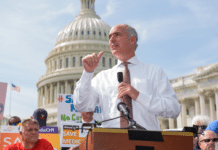This week, DFL Governor Walz made headlines by announcing his administration would pursue legislation mandating that 100 percent of Minnesota’s electricity come from “Clean Energy” by 2050. Per the usual, the Governor seemed to talk a good game, but there are large and important differences between the way he represented the proposal, and the actual text of the legislation, HF1956, brought forward in the Minnesota House of Representatives.
For example, the Governor and others speaking at the press conference said nuclear would count toward attaining the 100 percent clean energy requirement, but House File 1956, which was introduced by Representative Jamie Long, implies otherwise. Nuclear power is mentioned five times in the forty-page bill. Interestingly, the legislation that is supposed to fight climate change, which the Governor described as an existential threat, does not allow existing nuclear power to count as “carbon free.”

This means Minnesota’s existing nuclear power plants, Monticello and Prairie Island, which produced 23 percent of Minnesota’s electricity in 2017 wouldn’t be considered “carbon free” on paper.
What’s worse, these two plants generated electricity at a cost of $45 per megawatt hour (mwh), and $37/mwh in 2017, respectively, according to Federal Energy Regulatory Commission (FERC) Form 1 data. This easily makes these nuclear plants the lowest-cost source of unsubsidized carbon-free electricity in Minnesota, especially when the additional costs of load balancing, transmission, property taxes, and utility profits are taken into account.
Excluding existing nuclear power from this standard is legislative malpractice against Minnesota families and businesses. Prairie Island is a relatively young nuclear power plant. Its two reactors are only 45 and 46 years old, and they are currently licensed to run for 60 years. The same is true for the Monticello plant, which is 48 years old.
What makes this clause so infuriating is that there are currently six nuclear plants in the United Statesseeking permission from the Nuclear Regulatory Commission to operate for 80 years. By excluding existing nuclear, lawmakers are giving Xcel Energy zero incentive to keep these reactors online. In fact, it is an excuse to shutter these affordable power plants and build new ones at a massive cost to Minnesota families.
But that’s not what is says in the legislation, and I wish I were making this up.

Really? The authors of this bill don’t think that their decision to exclude existing nuclear power plants from qualifying as “carbon free” would impact the decision to continue operating them? It’s as if the legislators knew this criticism was coming, and they thought they could hide behind this subsection.
Furthermore, this legislation says nothing about lifting Minnesota’s ban new nuclear power plants. One would think that if this legislation were really about saving the planet with carbon-free technology, then this bill would serve to repeal the ban on new nuclear power plants that has been in effect since 1994. That does not appear to be the case here.
The Governor’s lip-service to nuclear power appears to be a bait-and-switch. Nuclear is ok, just not existing nuclear or new nuclear.
Additionally, HF 1956 does not allow for large hydro (hydroelectric dams greater than 100 MW in size) to count, either.
Color me cynical, but if the Governor and legislators are so worried about the impact of climate change in Minnesota, why would they outlaw the two lowest-cost, and reliable options from qualifying as carbon-free electricity? This does not pass the sniff test.
This legislation appears to be a license for monopoly utility companies to print money by padding their rate base by building expensive and unreliable wind and solar, and building battery storage projects. Minnesota should say “No Deal,” to this Green New Disaster.

















